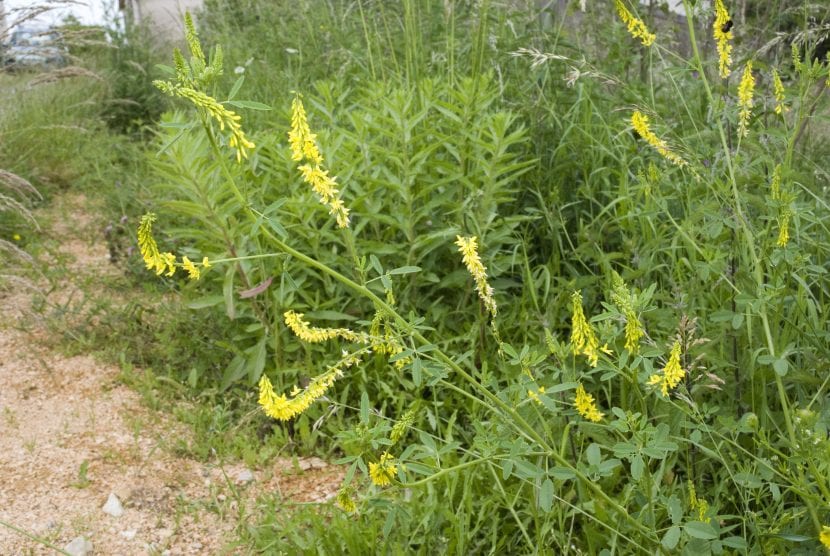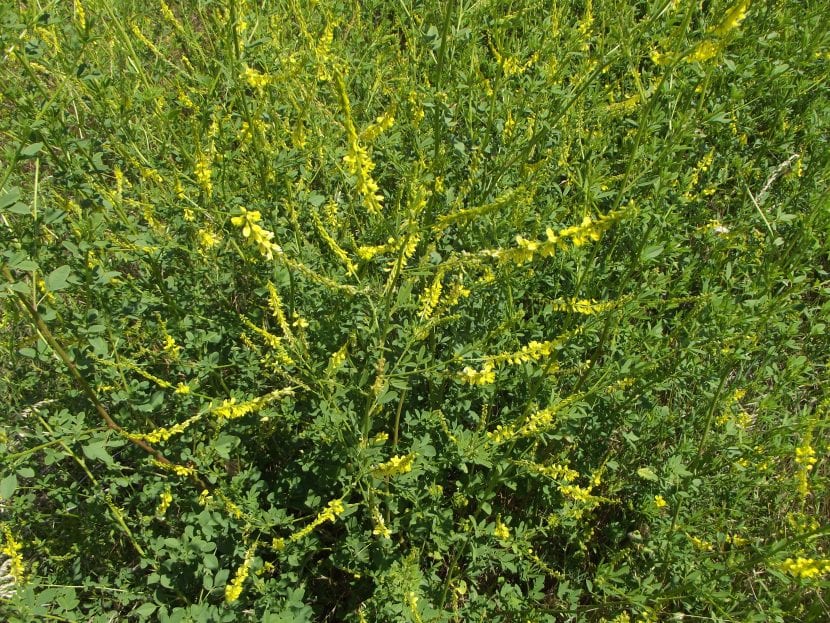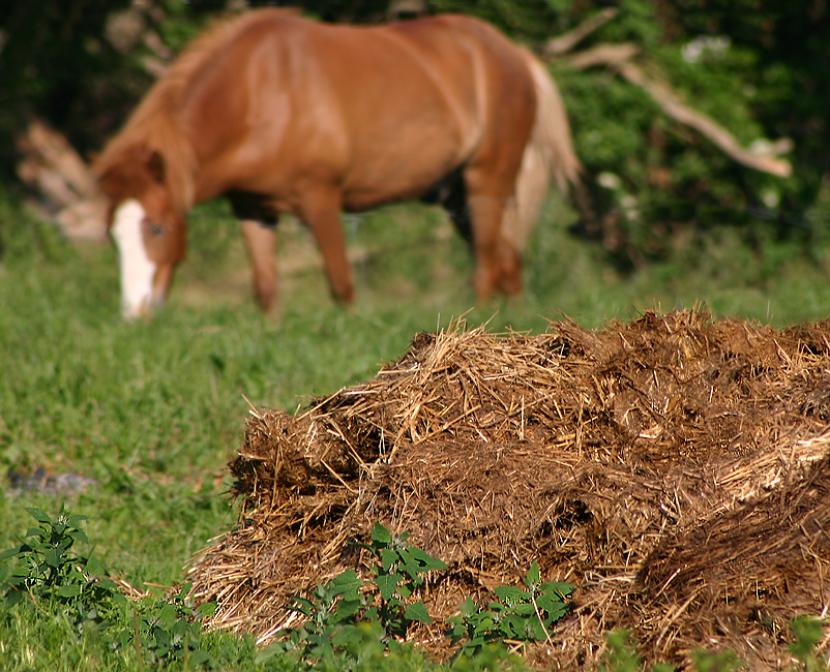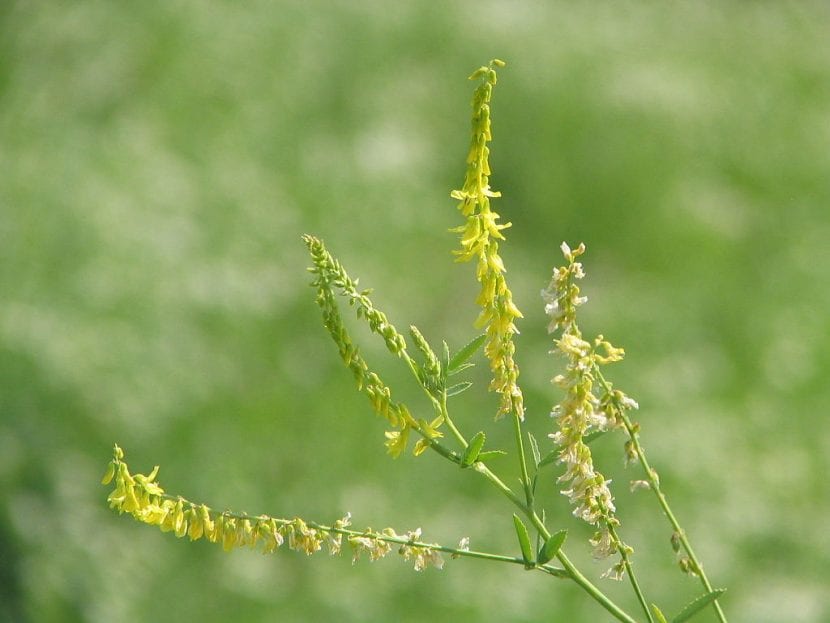
Image - Wikimedia / Olivier pichard
There are many common-looking herbs that it is highly recommended to grow in the garden, orchard or in pots. One of them is what is known as sweet clover, which is normally used as a forage plant, but as it has medicinal properties and its flowers are precious, We invite you to continue reading to know everything about it, including, what are the care it requires.
So you can expand (or start 😉) your collection of plants that, in addition to being decorative, can become great allies of your health.
Origin and characteristics of the meliloto

Image - Wikimedia / Bazov
Also known as sweet clover, yellow sweet clover or yellow clover, is an annual or biennial herb whose scientific name is Melilotus officinalis native to Europe that belongs to the Fabaceae family, that of legumes. Develops stems about 80 to 100cm, highly branched, from which sprout alternate leaves composed of three toothed leaflets, with an obovate to oblong shape, and with toothed margins.
The flowers, which appear in spring-summer, are small, yellow, and sprout in short, spike-like clusters. The fruit is an ovate, smooth legume with 1 to 2 seeds.
What are their cares?
It is a plant that usually grows spontaneously in open fields, so its care is very simple as you will be able to see:
Location
It is important to be in a sunny exposition, either accompanying other plants in the garden or orchard, or in individual pots. Even if you have a kitchen with a window that lets in a lot of light, you can put it on the shelf - as long as it's a bit wide - to keep it closer.
Earth
It is not demanding:
- Flower pot: you can use universal substrate (on sale here).
- Garden or orchard: it grows in a great variety of soils, although it prefers those with a neutral pH or somewhat alkaline; that is, with a pH between 7 and 8.
Irrigation

Image - Wikimedia / Olivier pichard
The frequency of irrigation will be high in summer, since the earth dries up very quickly. The rest of the year, and especially in autumn-winter, it will be necessary to water more sporadically in order to prevent the roots from rotting due to excess water.
For this reason, if you have doubts about when to water, checks the moisture of the substrate or soil with a meter or a stick. And if you have it in a pot, weigh it once it is watered and again after a few days, in this way just by doing this you will be able to know if it needs watering or not.
Also keep in mind that, when watering, the earth must be able to absorb water. If you have it in a pot and you see that it goes sideways, put it in a basin with the precious liquid for about 30 minutes; and if you have it on the ground, stick a stick in it several times on the sides of the plant.
Subscriber
From the beginning of spring to the end of summer, it doesn't hurt to give him a little extra "food". One or two handfuls of herbivorous animal manure if it is on the ground, or guano in liquid form (for sale here) if it is in a pot, they will make it grow wonderfully.

Multiplication
Meliloto multiplies by seeds in spring. The way to proceed is as follows:
- First, you have to fill a seedling tray (for sale here) or pot with universal substrate.
- Then, water thoroughly with a small watering can, like this 2-liter one sold here.
- Then, put a maximum of two seeds in each pot or socket. The germination rate of the herbs is very high (around 80-90%); This means that out of 100 seeds, the most probable is that 80 to 90 will germinate. Due to this, it is advisable not to put many in the same seedbed, because otherwise as they grow, very few will survive.
- Finally, they are covered with a thin layer of substrate, and the seedbed is placed outside, in semi-shade or in full sun.
Keeping the substrate moist but not waterlogged, you will begin to see your first melilots in a matter of 5-7 days.
Planting or transplanting time
Is planted late winter or early spring, as long as the minimum temperature is 15 degrees Celsius or more. It is an herb that does not like to be cold too much and that during the change from pot or pot to soil can have a bad time, hence it is better to wait for the weather to improve.
Rusticity
It resists frosts of up to -7ºC.
What medicinal uses does melilot have?

Image - Wikimedia / Bogdan
It is an herb that is used for its medicinal properties. It can be consumed as an infusion to improve blood circulation, something that will have a positive effect on the functioning of the veins and arteries, which in turn will serve to prevent or treat varicose veins and hemorrhoids.
You can buy a sachet here.
And with this we are done. We hope you have learned a lot about melilot, a very interesting herb 😉.